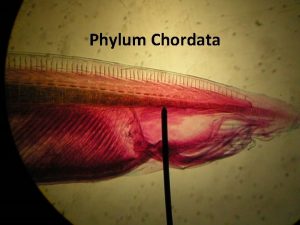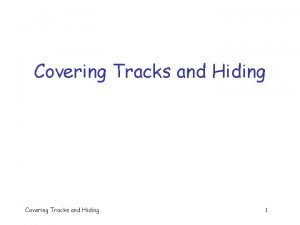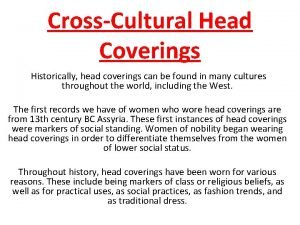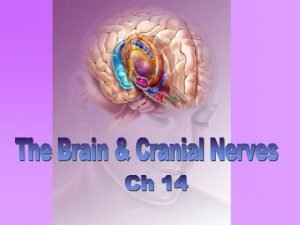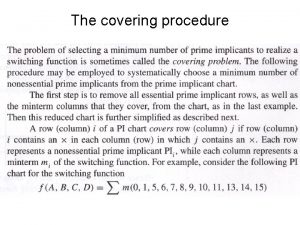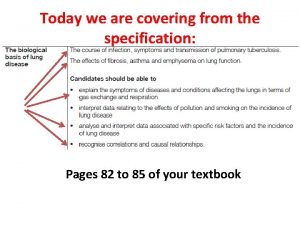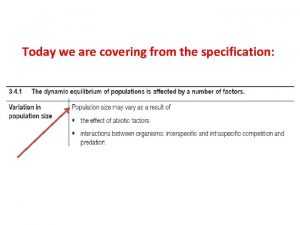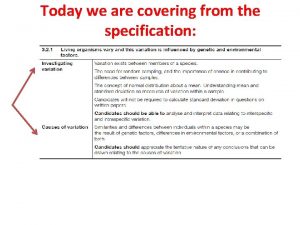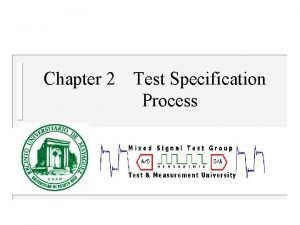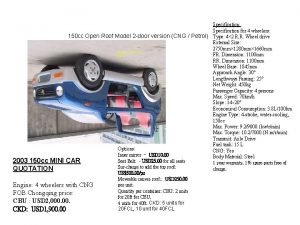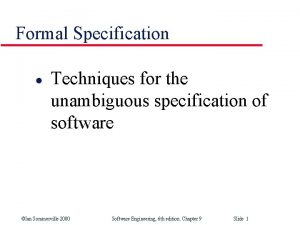Today we are covering from the specification Starter

































- Slides: 33

Today we are covering from the specification:

Starter 1. 2. 3. 4. What are antibiotics used for? Who can obtain antibiotics? When shouldn’t antibiotics be given? What does “resistant” mean?

What are antibiotics? • Antibiotics are substances which can inhibit growth or destroy bacteria. • They are produced by other living organisms, e. g. fungi.

Experiment to assess the efficiency of antibiotics in killing bacteria - 3 different bacterial cultures in liquid culture medium (you will use one) - 2 different antibiotics, one of which has 2 different strengths As you complete the practical, make a note of the method you use. Watch the demonstration carefully!

Homework Make a note of the method we used today. Bring it to the lesson on Monday.

Results – Lab Book • Draw a labelled diagram of your agar plate. • Measure the diameter of each clear area (the zone of inhibition). • Collect results from groups that have tested the other species of bacteria.

Questions 1. Describe how you used aseptic technique to ensure your agar plate didn’t become contaminated with other microorganisms. 2. Suggest what your results show (e. g. which is the ‘best’ antibiotic for killing each type of bacteria? ).

Discovery of Antibiotics

How do antibiotics work? There are two types of antibiotic: • Bacteriostatic – which inhibit growth of bacterial cells. • Bactericidal - which directly destroy bacterial cells.

Broad and narrow spectrum antibiotics Some antibiotics are able to be used against a wide range of pathogens – “broad spectrum”. Others are very specific in their targets and are said to be “narrow spectrum”.

Broad spectrum e. g. tetracycline Enter the bacterial cell and interfere with the metabolism e. g. protein synthesis. This will prevent the cell from functioning and growing or reproducing. Narrow spectrum e. g. penicillin Will act on specific processes only found in some bacteria e. g. cell wall formation.

Bacterial cell wall synthesis • Bacterial cells, like plant cells, constantly have an influx of water via osmosis. • Due to the rigid cell wall of bacterial cells they are able to withstand expansion and prevent further entry of water.

Bacterial cell walls & bactericidal antibiotics • Penicillin is a bactericidal antibiotic. • Inhibits an enzyme involved in cell wall formation. • No protection against excess water entering by osmosis. • Leads to osmotic lysis, killing the bacterium. • Only effective against bacterial cells which are growing and use a specific pathway for cell wall formation.

Why don’t antibiotics work against viruses? • Penicillin and other antibiotics work to inhibit cell wall formation or to disrupt other cell processes. • Viruses are non-living and do not have the same structure as bacteria; these processes don’t take place and therefore can’t be disrupted.

Testing the effectiveness of antibiotics

Antibiotic-sensitivity testing. Petri dishes were spread-inoculated with Staphylococcus albus (white growth) or Micrococcus luteus (yellow growth) before antibiotic assay "rings" were placed on the agar surface. The coloured disks at the end of each spoke of the rungs are impregnated with different antibiotics. Clockwise from the top (arrow) these are: Novobiocin, Penicillin G, Streptomycin (white disk), Tetracycline, Chloramphenicol, Erythromycin, Fusidic acid (green disk) and Methicillin. Clear zones of suppression of bacterial growth around the individual antibiotic disks are evidence of sensitivity to these antibiotics.

To do: • Read through the information on pages 188191 of the textbook. • Answer the questions in the yellow boxes on pages 192 -193.

Today we are covering from the specification:

Antibiotic resistance • Some strains of bacteria are resistant to antibiotics (e. g MRSA – methicillin-resistant Staphylococcus aureus) • This means that use of antibiotics against that strain will be ineffective.

Antibiotic resistance • Antibiotic resistance can arise from a mutation in the bacterial DNA. • Most often occurs in a plasmid. • The mutation may cause the bacteria to produce an enzyme that blocks the action of the antibiotic, or breaks it down.

Example: • A mutation occurrs in a Streptococcus pneumoniae bacterium. • This mutation means that the bacterial cell is able to synthesise a new protein. • The new protein is an enzyme which is able to break down the penicillin before it takes effect. • The enzyme is called penicillinase. • The S. pneumoniae bacterium is now resistant to penicillin.

How do bacteria reproduce? • Asexually, via binary fission. • This does not lead to an increase in variation. • Asexual reproduction also means that the DNA is not altered as it is via sexual reproduction. • Therefore bacterial cells have another way of passing genetic information between one another.

This means that bacteria can pass on genes for antibiotic resistance to their offspring. This is vertical transmission. Bacterial DNA Plasmid containing resistance gene

Antibiotic resistance • Mutations are not only passed on vertically but can also be passed on via horizontal gene transmission. Plasmid containing resistance gene Bacterial DNA Bacterium with no antibiotic resistance genes

Antibiotic resistance Plasmid is replicated and passed to second bacterium Pilus/ conjugation tube

Antibiotic resistance Both bacteria now contain a copy of the plasmid which contains an antibiotic resistance gene.

Antibiotic resistance • Conjugation between bacterial species also means that antibiotic resistance is not contained to one species. • This also means that bacterial cells can now also be resistance to a range of different antibiotics.

The role of natural selection What is natural selection? - Mutation Variation Competition Best adapted organisms survive They are able to pass on their beneficial alleles. How does this apply to antibiotic resistance in bacteria?

Natural Selection and Antibiotic Resistance - Mutation – a bacterium is produced with a mutation in a gene that confers antibiotic resistance. - Variation – after horizontal/vertical transmission, some bacteria have the resistance allele, others don’t. - Competition – bacteria reproduce and those that are not resistant will be killed by the antibiotic. - Best adapted organisms survive – resistant bacteria survive. - They are able to pass on their beneficial alleles – resistance allele can be transmitted to others by horizontal/vertical transmission.

To Do: • “MRSA” Worksheet • Read the two passages first. • Answer all of the questions in as much detail as you can. • You may write on the sheet. 17 minutes

Resistance in TB • Mycobacterium tuberculosis is a causative agent of TB. • Antibiotic treatment of TB is challenging as a course of treatment can last 6 -9 months. • Initially, weak strains of the M. tuberculosis are killed off. • Some patients then feel better and cease their antibiotics.

Resistance in TB • This means that stronger and more resistant strains of M. tuberculosis are able to reproduce with less competition. • These strains are then more likely to be spread to others. • They are also likely to take part in conjugation and become resistant to multiple antibiotics. • To overcome this problem, sufferers of TB are given a cocktail of 4 different antibiotics.

To Do: Check that you understand the topic we have just covered. Use the textbook to help if necessary. Ask if you still don’t understand! Answer the questions about multi-drug resistant TB on the sheet. Bring your work to hand in next lesson.
 Mikael ferm
Mikael ferm Upper specification limit and lower specification limit
Upper specification limit and lower specification limit Upper specification limit and lower specification limit
Upper specification limit and lower specification limit Are we having class today
Are we having class today Example of repitition
Example of repitition Meeting objective
Meeting objective Fingerprint ridge characteristics worksheet
Fingerprint ridge characteristics worksheet For todays meeting
For todays meeting Today's lesson or today lesson
Today's lesson or today lesson Animals that have a notochord
Animals that have a notochord Find duck
Find duck Covering tracks
Covering tracks Set covering machine
Set covering machine Tough outer covering of bone
Tough outer covering of bone Christian headcovering
Christian headcovering Membrane covers the heart
Membrane covers the heart Onychoptosis is the periodic
Onychoptosis is the periodic Whats a covering letter
Whats a covering letter For placing an order
For placing an order Dartos muscle
Dartos muscle Cigna vitamin d policy
Cigna vitamin d policy Phylum chordata
Phylum chordata Signed statement for head covering
Signed statement for head covering Non chordata
Non chordata Induction as inverted deduction in machine learning
Induction as inverted deduction in machine learning The scale structure covering the exterior of the hair
The scale structure covering the exterior of the hair Coverings of the brain
Coverings of the brain What is the gooey liquid in plant and animal cells
What is the gooey liquid in plant and animal cells Cigna not covering vitamin d testing
Cigna not covering vitamin d testing Two weeks notice letter
Two weeks notice letter Double layered membrane of lungs
Double layered membrane of lungs Name two basic reasons for covering cargo on an open bed
Name two basic reasons for covering cargo on an open bed Outer covering definition
Outer covering definition Spinous pattern
Spinous pattern









